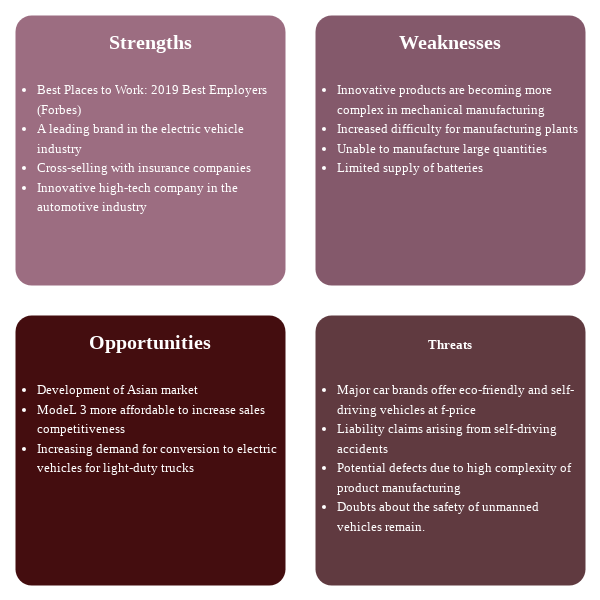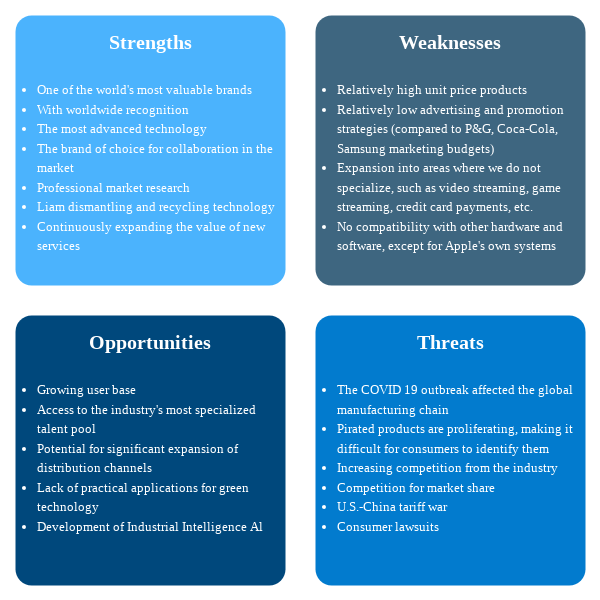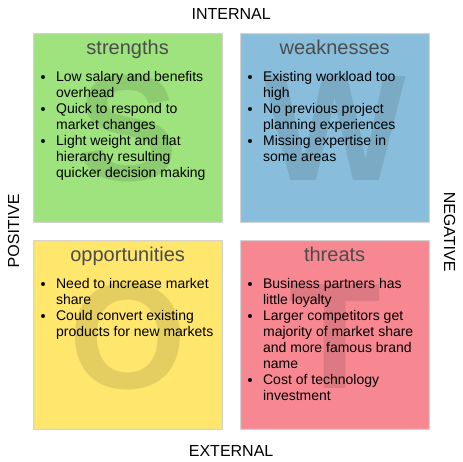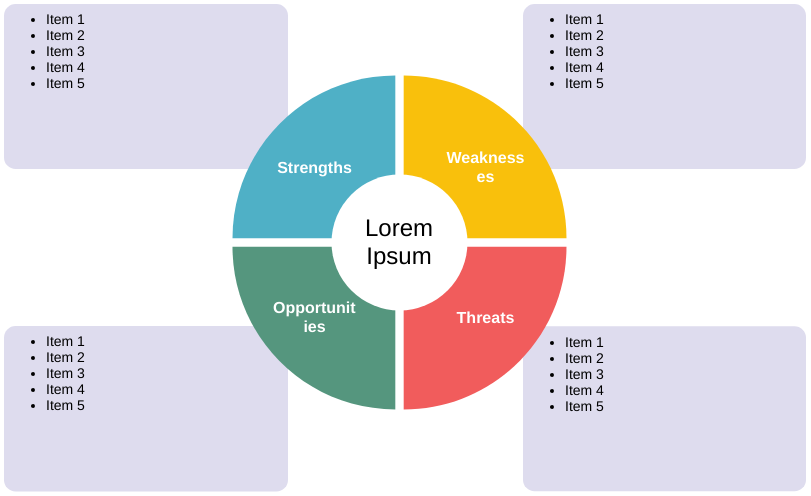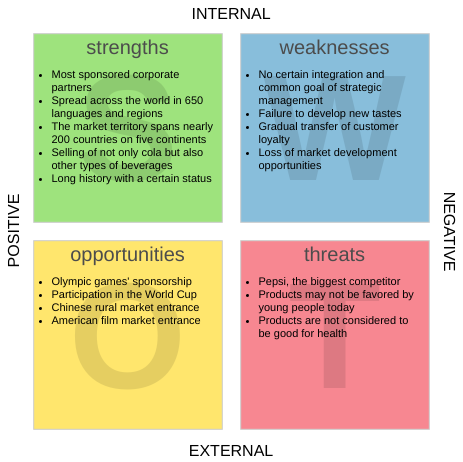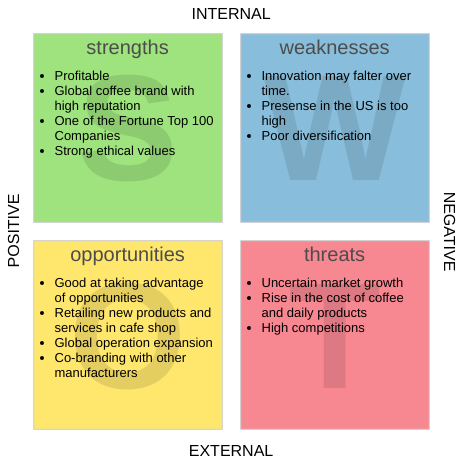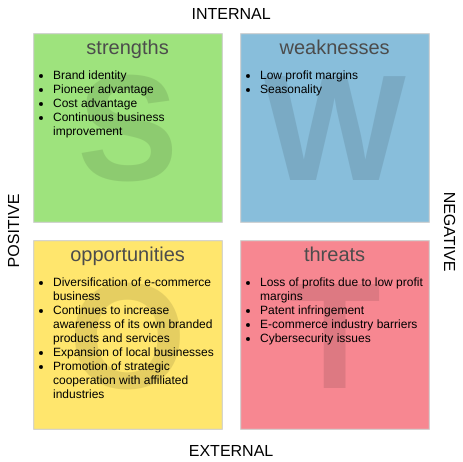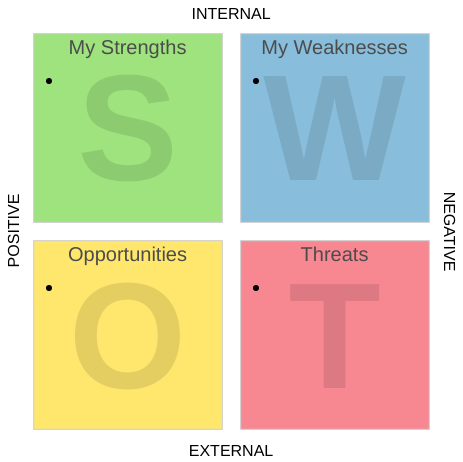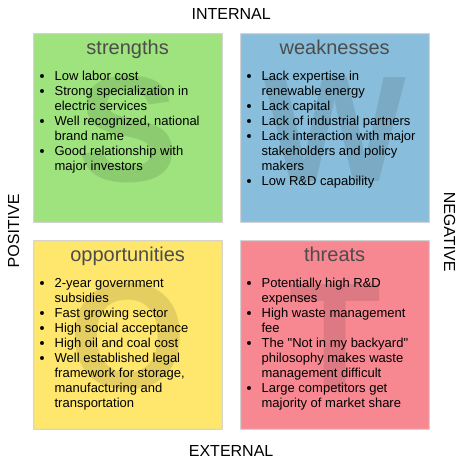Czym jest metoda analizy SWOT?
Analiza SWOT to metoda analizy sytuacyjnej oparta na analizie wewnętrznego i zewnętrznego środowiska w warunkach konkurencyjnych. Jest również używana jako potężne narzędzie dla firm do przeprowadzania analizy rynku w kontekście formułowania strategii korporacyjnej i analizy konkurencji.
SWOT oznacza mocne strony, słabe strony, możliwości i zagrożenia i jest narzędziem analizy strategicznej, które pomaga analizować wewnętrzne i zewnętrzne czynniki, które mogą wpływać na Twoją organizację, projekt lub przedsięwzięcie biznesowe. Analiza SWOT, znana również jako macierz SWOT, porządkuje zidentyfikowane mocne strony, słabe strony, możliwości i zagrożenia w łatwy do zrozumienia sposób w 4 polach.
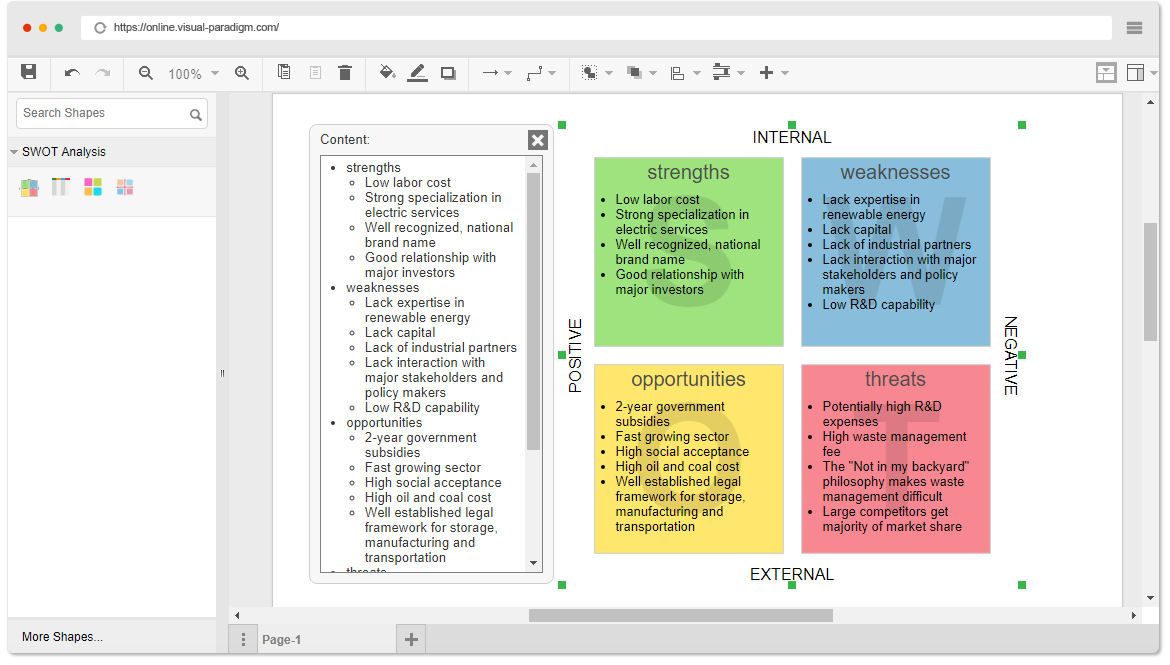
Czynniki wewnętrzne vs zewnętrzne
SWOT składa się głównie z dwóch osi krzyżowych: „Zewnętrzne, Wewnętrzne” oraz „Pozytywne, Negatywne”, które można wyprowadzić z mocnych stron, słabych stron, możliwości i zagrożeń (jak pokazano na powyższym rysunku), i jest to bardzo powszechny i łatwy sposób analizy obecnej sytuacji firmy, produktu lub osoby, a także może być używany jako środek do rozwiązywania problemów.
Czynniki wewnętrzne: Mocne strony + Słabe strony
Czynniki wewnętrzne w analizie SWOT obejmują mocne i słabe strony, więc dlaczego mocne i słabe strony są klasyfikowane jako czynniki wewnętrzne? Przejdźmy dalej, aby to zobaczyć.
Mocna strona
Mocna strona to kluczowe zasoby i technologie, które posiadasz, lub to, w czym jesteś najlepszy i najbardziej odpowiedni do działania. Bloki mocnych stron mogą również reprezentować Twoją własną lub Twojej firmy ekspertyzę lub lepsze umiejętności niż inni. Na przykład szeroka sieć kontaktów, wysoko konkurencyjny produkt, silna marka, lojalna baza klientów, unikalna technologia itp.
Myślenie o mocnych stronach.
- Co firma może zrobić, czego nikt inny nie może zrobić?
- Jakie produkty lub strategie marketingowe były udane?
- W jakich obszarach firma ma doświadczenie
- Zasoby, którymi dysponuje firma
Słabe strony
Słabe strony to to, w czym jesteś najmniej dobry i najmniej odpowiedni do działania. Słabe strony mogą również odzwierciedlać słabości firmy i potencjalne niedociągnięcia. Na przykład brak świadomości marki, niski udział w rynku, wysoki poziom zadłużenia, brak kapitału lub brak kultury korporacyjnej itp.
Pomyśl o następujących obszarach słabości.
- Obszary, w których firma nie odnosi sukcesów
- Brak zasobów i technologii
- Czy istnieją przeszkody w wewnętrznych operacjach firmy?
- Mocne i słabe strony są klasyfikowane jako czynniki wewnętrzne, ponieważ oba czynniki są głównie związane z własnymi warunkami firmy.
Czynniki zewnętrzne: Możliwość + Zagrożenie
Czynniki zewnętrzne w analizie SWOT obejmują możliwości i zagrożenia, więc dlaczego możliwości i zagrożenia są klasyfikowane jako czynniki zewnętrzne? Przejdźmy dalej, aby to zobaczyć.
Możliwość
Możliwość to to, czy Ty lub Twoi konkurenci mogą znaleźć nowe niszowe rynki dla swoich produktów, technologii i usług. Czy możliwe jest opracowanie nowych konkurencyjnych produktów lub usług? Możliwość może być przyszłą przewagą firmy i zazwyczaj jest związana z otoczeniem gospodarczym oraz decyzjami rządowymi. Na przykład obniżki ceł, zwiększone zapotrzebowanie konsumenckie itp.
Myślenie o kierunku możliwości.
- Usługi lub towary, które firma może rozwinąć w przyszłości
- Zwiększone zapotrzebowanie na towary firmy
- Możliwe korzyści z przyszłych zmian na rynku
- Pozytywne efekty zmian w przepisach rządowych
Zagrożenie
Czy istnieje zagrożenie, że Twoje produkty, technologie lub usługi zostaną zastąpione? A może rynek stopniowo się pogarsza? Zagrożenia to negatywne czynniki, które są szkodliwe dla wzrostu firmy. Do powszechnych zagrożeń należą wzrost kosztów surowców, niedobór siły roboczej, wzrost konkurencji lub wprowadzenie wysoko konkurencyjnych produktów przez konkurentów.
Kierunek myślenia o zagrożeniach.
- Jak zareagują konkurenci?
- Czy są potencjalni konkurenci?
- Możliwe zagrożenia z przyszłych zmian na rynku
- Czy relacje z dostawcami produktów są silne?
- Te dwa wymiary często określane są jako czynniki zewnętrzne, głównie dlatego, że czynniki, które na nie wpływają, są zasadniczo związane ze zmianami w otoczeniu zewnętrznym.
Jakie są kroki analizy SWOT?
Ogólnie rzecz biorąc, istnieją cztery kroki.
- Analiza czynników środowiskowych – Analiza różnych czynników środowiskowych, wewnętrznych, zewnętrznych, potencjalnych i przyszłych sytuacji itp., powinna być kompleksowa i dogłębna oraz przeprowadzona z różnych perspektyw.
- Zbuduj macierz SWOT – Zidentyfikuj swoje mocne strony, słabe strony, możliwości i zagrożenia, a następnie zbuduj macierz SWOT, aby uwzględnić te elementy. Oczywiście możesz najpierw przeprowadzić analizę SW, następnie analizę OT, a na końcu zintegrować te elementy, aby utworzyć macierz SWOT.
- Opracuj plan działania – Po zakończeniu analizy czynników środowiskowych i budowy macierzy SWOT możesz stworzyć odpowiedni plan działania. Podstawowa idea planu to:
- Wykorzystać mocne strony,
- Pokonać słabe strony,
- Wykorzystać możliwości i
- Rozwiązać zagrożenia.
- Rozważ przeszłość, opierając się na teraźniejszości i patrząc w przyszłość – Zidentyfikuj niedociągnięcia przeszłego zachowania, porównaj je z teraźniejszością i pomyśl, jak je rozwijać w przyszłości.
Stosując zintegrowane podejście analizy systemowej, te ustalenia są dopasowywane do różnych rozważanych czynników środowiskowych i łączone w celu zaproponowania szeregu alternatywnych strategii rozwoju w przyszłości.
Zalecane narzędzie SWOT online
VP Online oferuje oparte na sieci oprogramowanie do analizy SWOT które ułatwia szybkie opracowanie modelu analizy SWOT za pomocą intuicyjnego edytora danych opartego na liście. Możesz skupić się na wypisywaniu informacji w punktach. Visual Paradigm automatycznie utworzy macierz SWOT na podstawie dostarczonych informacji.
Internetowy startup małych firm
Szablon analizy SWOT (Sześciokąt)
Ten post dostępny jest również w Deutsch, English, Español, فارسی, Français, Bahasa Indonesia, 日本語, Portuguese, Ру́сский, Việt Nam, 简体中文 and 繁體中文














